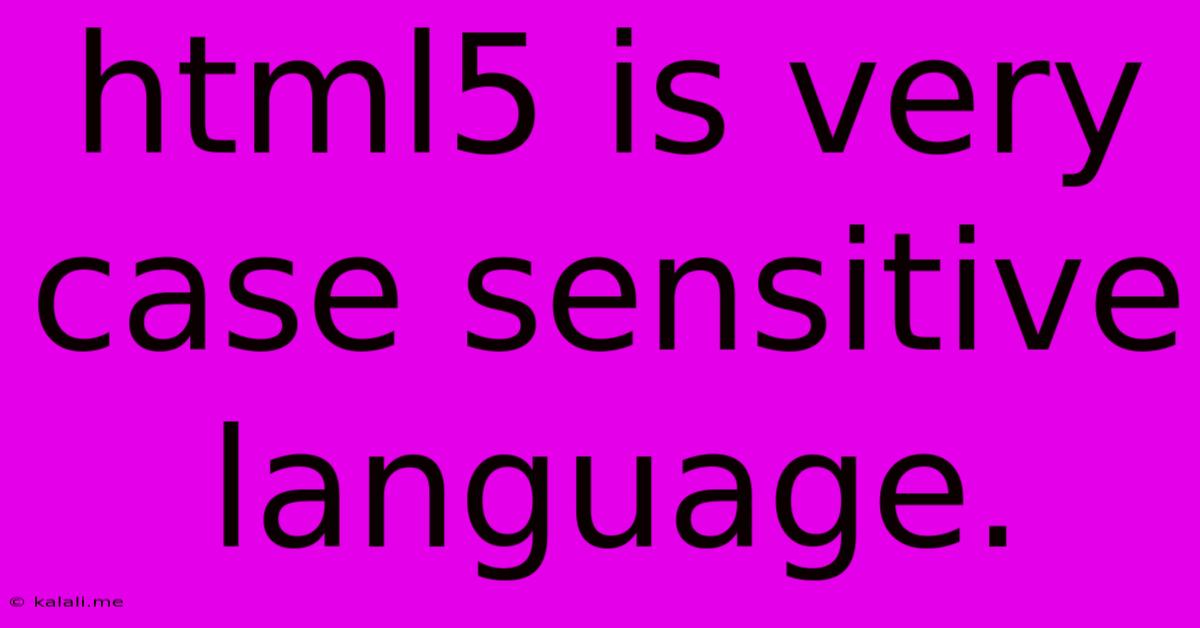Html5 Is Very Case Sensitive Language.
Kalali
May 25, 2025 · 3 min read

Table of Contents
HTML5: A Case-Sensitive Language – Why and How It Matters
HTML5, like many programming languages, is case-sensitive. This seemingly small detail has significant implications for developers, impacting code functionality and potentially causing frustrating debugging sessions. Understanding case sensitivity in HTML5 is crucial for writing clean, efficient, and error-free code. This article will delve into why HTML5 is case-sensitive, the specific elements affected, and how to avoid common pitfalls.
Why is HTML Case-Sensitive?
The case sensitivity of HTML5 stems from its underlying structure and how web browsers interpret the code. Browsers parse HTML documents and identify elements based on their exact case. While some attributes might appear to be forgiving, inconsistencies can lead to unexpected behavior or complete failure to render elements correctly. This strict adherence to case is vital for maintaining the integrity and predictability of the language. Think of it as a crucial part of the HTML vocabulary – spelling matters!
Elements Affected by Case Sensitivity:
While the entire HTML5 specification isn't uniformly case-sensitive in all its aspects, several key components demonstrate this behavior. Primarily, HTML tags are case-sensitive. This includes:
- Opening and closing tags:
<p>and</p>are distinct from<P>and</P>. Using inconsistent capitalization can prevent proper nesting and result in broken layouts. - Attribute names:
class="myClass"is different fromCLASS="myClass". While the browser might sometimes handle this seemingly minor error, it's best practice to maintain consistency. - Attribute values: In some cases, particularly when dealing with JavaScript or CSS integration, attribute values are also case-sensitive. For example,
onclick="myFunction()"is not the same asONCLICK="myFunction()".
Common Mistakes and How to Avoid Them:
Developers often encounter issues due to overlooked case sensitivity. Here are some common mistakes and solutions:
- Inconsistent capitalization of tags: Always use lowercase for HTML tags (
<p>,<h1>,<div>) for consistency and best practices. This is the recommended standard and prevents potential errors. - Incorrect attribute names: Double-check the spelling and capitalization of attribute names (like
class,id,style) when writing your HTML. Using a consistent coding style and a good code editor with syntax highlighting can greatly help. - Typos in attribute values: Carefully review the capitalization within attribute values, particularly when dealing with Javascript functions or CSS class names.
Best Practices for Case Sensitivity:
- Use a code editor: Modern code editors (like VS Code, Sublime Text, Atom) often provide syntax highlighting and auto-completion features, assisting in maintaining consistent case and catching potential errors.
- Use a consistent coding style: Choose a coding style (lowercase for tags, camelCase for JavaScript variables, etc.) and stick to it throughout your project.
- Validate your HTML: Using HTML validators helps identify case-sensitive errors and other potential issues in your code before deployment.
Conclusion:
Understanding and respecting the case sensitivity of HTML5 is vital for developing robust and error-free websites. While some browsers might display partially correct results even with capitalization errors, adhering to best practices guarantees consistent functionality and maintainability. By using appropriate tools and adopting a consistent coding style, developers can avoid common pitfalls and produce cleaner, more efficient HTML5 code. This contributes to a more streamlined development process and a better user experience.
Latest Posts
Latest Posts
-
How Many Cups Is 1 Pound Of Cheese
Jul 12, 2025
-
30 X 30 Is How Many Square Feet
Jul 12, 2025
-
How Much Does A Half Oz Weigh
Jul 12, 2025
-
Calories In An Omelette With 3 Eggs
Jul 12, 2025
-
How Do You Say Great Grandmother In Spanish
Jul 12, 2025
Related Post
Thank you for visiting our website which covers about Html5 Is Very Case Sensitive Language. . We hope the information provided has been useful to you. Feel free to contact us if you have any questions or need further assistance. See you next time and don't miss to bookmark.